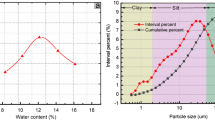Abstract
The changes in the shrinkage and physicochemical properties of untreated and treated organic soil using several chemical additives were investigated. In order to evaluate the effect of each chemical solution on the peaty soil environment different experiments namely; shrinkage limit, unconfined compressive strength (UCS), pH test, and water content were undertaken. The results of the laboratory experiments are further proved and interpreted using the X-ray diffraction, scanning electron microscopy (SEM), and energy-dispersive X-ray spectroscopy tests. The result unveils the structure of the treated soil significantly changed depending upon the used additive type and concentrations. The rate of shrinkage largely decreased when sodium silicate additives are used. In addition, it was observed that UCS value increased up to 500% and water content reduced up to 50% in comparison with untreated samples, depend on the amount of used non-traditional additives. The SEM micrographs of the sample before and after treatment validate the results obtained and analyzed from experiments.









Similar content being viewed by others
References
Åhnberg H, Johansson SE, Pihl H, Carlsson T (2003) Stabilising effects of different binders in some Swedish soils. Gr Improv 7(1):9–23
Anagnostopoulos CA (2005) Laboratory study of an injected granular soil with polymer grouts. Tunn Undergr Space Technol 20(6):525–533
ASTM D-4187 (1985) Zeta potential of colloids in water and waste water. D4187-82. American Society for Testing and Materials, West Conshohocken
Axelsson K, Johansson SE, Anderson R (2000) Stabilisation of organic soils by cement and pozzolanic reactions: feasibility study. Swedish Geotechnical Institute, Swedish Deep Stabilisation Research Centre, Sweden, pp 15–16
Chen H, Wang Q (2006) The behaviour of organic matter in the process of soft soil stabilization using cement. Bull Eng Geol Environ 65:445–448
Diamond S, Kinter EB (1965) Mechanisms of soil-lime stabilization—an interpretative review. Highw Res Rec 92:83–92
Edil TB (2001) Site characterization in peat and organic soils. In: Proceedings of international conference on in situ measurement of soil properties and case histories, Bali, Indonesia pp 49–59
EuroSoilStab (2002) Development of design and construction methods to stabilise soft organic soils. Design guide, soft soil stabilisation. Building Research Establishment
Fatahi B, Le TM, Fatahi B, Khabbaz H (2013) Shrinkage properties of soft clay treated with cement and geofibers. Geotech Geol Eng 31(5):1421–1435
Gillman GP, Sumpter EA (1986) Modification to the compulsive exchange method for measuring exchange characteristics of soils. Aust J Soil Res 24(1):61–66
Gleize PJP, Müller A, Roman HR (2003) Microstructural investigation of a silica fume–cement–lime mortar. Cem Concr Compos 25(2):171–175
Latifi N, Marto A, Eisazadeh A (2015) Analysis of strength development in non-traditional liquid additive-stabilized laterite soil from macro-and micro-structural considerations. Environ Earth Sci 73(3):1133–1141. doi:10.1007/s12665-014-3468-2
Latifi N, Marto A, Eisazadeh A (2016a) Physicochemical behavior of tropical laterite soil stabilized with non-traditional additive. Acta Geotech 11(2):433–443. doi:10.1007/s11440-015-0370-3
Latifi N, Meehan CL, Abd Majid MZ, Horpibulsuk S (2016b) Strengthening montmorillonitic and kaolinitic clays using a calcium-based non-traditional additive: a micro-level study. Appl Clay Sci 132:182–193. doi:10.1016/j.clay.2016.06.004
Latifi N, Rashid ASA, Marto A, Tahir MM (2016c) Effect of magnesium chloride solution on the physico-chemical characteristics of tropical peat. Environ Earth Sci 75(3):9. doi:10.1007/s12665-015-4788-6
Latifi N, Rashid ASA, Siddiqua S, Abd Majid MZ (2016d) Strength measurement and textural characteristics of tropical residual soil stabilised with liquid polymer. Measurement 91:46–54. doi:10.1016/j.measurement.2016.05.029
Mesri G, Ajlouni M (2007) Engineering properties of fibrous peats. J Geotech Geoenviron Eng 133(7):850–866
Mitchell JK, Soga K (2005) Fundamentals of soil behavior. Wiley, Hoboken
Moayedi H, Kazemian S, Huat BB (2013) Shear strength parameters of improved peat by chemical stabilizer. Geotech Geol Eng 31(4):1089–1106
Moayedi H, Mosallanezhad M, Nazir R, Kazemian S, Huat BK (2014a) Peaty soil improvement by using cationic reagent grout and electrokinetic method. Geotech Geol Eng 32(4):933–947
Moayedi H, Nazir R, Kazemian S, Huat BK (2014b) Microstructure analysis of electrokinetically stabilized peat. Measurement 48:187–194
Mohamedelhassan E, Shang JQ (2008) Electrokinetic cementation of calcareous sand for offshore foundations. Int J Offsh Polar Eng 18(01):73–80
Raftari M, Rashid AS, Kassim KA, Moayedi H (2014) Evaluation of kaolin slurry properties treated with cement. Measurement 50:222–228
Rashid AS, Kalatehjari R, Noor NM, Yaacob H, Moayedi H, Sing LK (2014) Relationship between liquidity index and stabilized strength of local subgrade materials in a tropical area. Measurement 55:231–237
Shafigh P, Ghafari H, Bin Mahmud H, Jumaat MZ (2014) A comparison study of the mechanical properties and drying shrinkage of oil palm shell and expanded clay lightweight aggregate concretes. Mater Des 60:320–327. doi:10.1016/j.matdes.2014.04.001
Shang JQ, Mohamedelhassan E, Ismail MA (2004) Electrochemical cementation of offshore calcareous soil. Can Geotech J 41(5):877–893
Slowik V, Hübner T, Schmidt M, Villmann B (2009) Simulation of capillary shrinkage cracking in cement-like materials. Cement Concr Compos 31(7):461–469
Von Post L (1922) Sveriges geologiska undersöknings torvinventering och några av dess hittills vunna resultat. Svenska Mosskulturföreningens Tidskrift 1:1–27
Wang Z, Xu S, Yan L, Guo P, Qian C (2011) Shrinkage properties of cement solidified sludge with high water content. In: International conference on structures and building materials, January 07–09, 2011. Advanced Materials Research. Advances in Building Materials, PTS 1-3, vol 168-170. Guangdong Univ Technol, Fac Civil & Transportat Engn, Guangzhou, pp 1496–1500
Zulkifley M, Ng TF, Raj JK, Hashim R, Bakar AFA, Paramanthan S, Ashraf MA (2014) A review of the stabilization of tropical lowland peats. Bull Eng Geol Environ 73(3):733–746
Zuo R, Örnek D, Syrett BC, Green RM, Hsu CH, Mansfeld FB, Wood TK (2004) Inhibiting mild steel corrosion from sulfate-reducing bacteria using antimicrobial-producing biofilms in Three-Mile-Island process water. Appl Microbiol Biotechnol 64(2):275–283
Author information
Authors and Affiliations
Corresponding author
Rights and permissions
About this article
Cite this article
Moayedi, H., Mosallanezhad, M. Physico-Chemical and Shrinkage Properties of Highly Organic Soil Treated with Non-traditional Additives. Geotech Geol Eng 35, 1409–1419 (2017). https://doi.org/10.1007/s10706-017-0184-1
Received:
Accepted:
Published:
Issue Date:
DOI: https://doi.org/10.1007/s10706-017-0184-1




